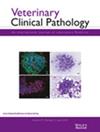A clinical and hematologic approach to basophilia in dogs, cats, and horses
Abstract
Background
Basophils are the rarest blood leukocyte in most healthy domestic mammals and the clinical significance of basophilia is poorly understood.
Objectives
To empirically determine magnitude thresholds for basophilia, identify its hematologic correlates, and identify associations between breeds, specific diseases, disease categories, organ systems, and basophilia in dogs, cats, and horses.
Methods
CBCs and clinical information from dogs, cats, and horses were collected from the University of California-Davis School of Veterinary Medicine between 2000 and 2020. Relationships between basophil concentration and other CBC parameters were evaluated by computing Pearson's correlation (r). Magnitude thresholds for basophilia (ie, mild, moderate, severe) were determined by evaluating the distribution of basophil counts for each species. For severe cases of basophilia, the clinical diagnoses were categorized by the organ system affected and the underlying pathomechanism. Basophilia groups were compared to a time-matched, randomly selected control group, and chi-square analyses were performed to evaluate associations with disease.
Results
A total of 143 841 (dog), 32 576 (cat), and 44 887 (horse) CBCs were collected. For all three species, basophilia was over-represented in some breeds. Basophilia was associated with respiratory disease in both dogs and cats. In dogs, lymphoma and mast cell neoplasia were associated with basophilia. In horses, an increased incidence of basophilia was not associated with any disease category or organ system.
Conclusions
This is the largest study evaluating the hematologic correlations and disease associations with basophilia in dogs, cats, and horses. While basophilia was reported alongside many diseases, certain associations may aid clinicians in narrowing down underlying causes.


 求助内容:
求助内容: 应助结果提醒方式:
应助结果提醒方式:


